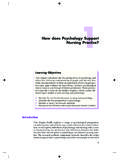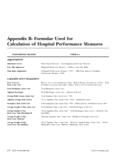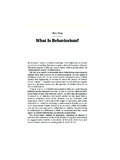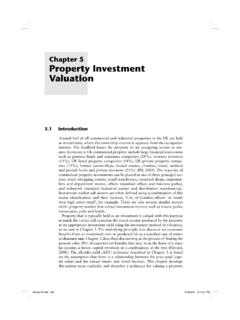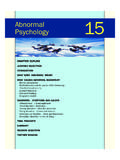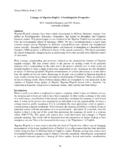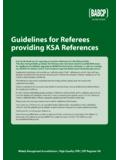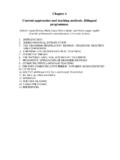Transcription of 36 Discourse Analysis and Language Teaching
1 Discourse Analysis and Language Teaching 707. 36 Discourse Analysis and Language Teaching ELITE OLSHTAIN AND MARIANNE. CELCE-MURCIA. 0 Introduction: The Interface of Discourse Analysis and Language Teaching The communicative approach to Language Teaching , which began in the early 1970s and gradually took over most of Language Teaching in the world, at least in ideology . if not in practice, has made people aware of the need to focus on communicative features of Language use as an integral part of the Teaching program. It is widely accepted in the field that we teach both Language for communication and Language as communication.
2 In other words, the objective of Language Teaching is for the learners to be able to communicate by using the target Language , even if at times this is limited communication, and the most effective way to teach Language is by using it for communication. So, given this premise, the goal of Language Teaching is to enable the learner to communicate and the method for Teaching is for the learner to experi- ence and practice relevant instances of communication. It would be ill-advised to teach Language via the communicative approach without relying heavily on Discourse Analysis .
3 In fact Discourse Analysis should provide the main frame of reference for decision-making in Language Teaching and learning. Cre- ating suitable contexts for interaction, illustrating speaker/hearer and reader/writer exchanges, and providing learners with opportunities to process Language within a variety of situations are all necessary for developing learning environments where Language acquisition and Language development can take place within a communicat- ive perspective. Discourse Analysis and pragmatics are relevant to Language Teaching and Language learning since they represent two related Discourse worlds that characterize human communication.
4 The first represents intended meaning transmitted within context, and is, therefore, concerned with sequential relationships in production; and the other explains the interpreted meaning resulting from linguistic processing and social inter- action, all the while taking into account a variety of contextual factors, at the receptive end. Language Teaching needs to focus on both (1) strategies of message construc- tion to facilitate learner production of the communicative intent and (2) strategies of 708 Elite Olshtain and Marianne Celce-Murcia interpretation, in order to ensure some ability on the learner's part to process inferen- tially (even if only approximately) the speaker/writer's intent.
5 For many years during the first half of the twentieth century and well into the second half, Language Teaching , like linguistics, used the sentence as its basic unit of Analysis . In Language Teaching this meant that rules, examples, exercises, and activ- ities focused on individual sentences. Consequently, this was an approach which legitimized decontextualized Language practice. Individual sentences can be interest- ing, unusual, or mysterious, but when separated from context, they lack real mean- ing. Generations of learners practiced sentences in the target Language and remained quite incapable of linking these sentences into meaningful stretches of Discourse .
6 In the more recent approaches to Language learning and Teaching , Discourse or text has become the basic unit of Analysis . More recent Language textbooks present texts, short or long, as a basis for both understanding and practicing Language use within larger meaningful contexts. This approach has greatly altered the type of activities under- taken in Language classrooms. Learners need to focus, therefore, on various Discourse features within any specified Language activity. Another perspective that was added to Language materials and classroom activit- ies, once Discourse became the unit of Analysis , is the set of sociolinguistic features that accompany any natural interaction.
7 The real or imaginary participants involved in a communicative activity in the classroom become important. If the classroom activity is to represent real-life interaction, then age, social status, and other personal characteristics of the interactants cannot be ignored, and learners are expected to develop awareness of the linguistic choices which are related to such features. They need to gain experience in decision-making related to choices of linguistic representa- tions that are compatible with the characteristics of the participants and with the pragmatic features of the given situation.
8 Simulated speech events become an import- ant feature of the Language classroom, and although such a simulated speech event is a classroom artifact, it must represent as closely as possible a real speech event that could occur in natural interaction. Prior to adoption of the communicative approach to Language Teaching , the main goal of the Language classroom was to supply students with the ability to produce and recognize linguistically acceptable sentences. The communicative approach added a very important new dimension: communication strategies. The underlying notion of the approach recognizes the fact that learners may never achieve full linguistic competence and yet they will need to use the target Language for various types of communication.
9 One needs to develop, therefore, communication strategies that overcome and compensate for the lack of linguistic knowledge. Such communication strategies are partly universal in nature from the learner's point of view, since some can successfully be transferred from the first Language . Thus, learners who are good communicators in their first Language have a good chance of also becoming effective communicators in their second, although they may not know the second Language nearly as well as the first. We are referring here to the ability to paraphrase, use circumlocution and gestures, among other things, during spoken communication.
10 These abilities seem to be quite transferable if the Language classroom provides suffi- cient opportunities for using such strategies in the second Language . As a result of the general acceptance of the communicative approach, Language learning and Language Teaching have had to fully incorporate communicative inter- action into the curriculum. The fact that Language users exhibit linguistic, cultural, and Discourse Analysis and Language Teaching 709. social identities in a real-life interaction affects the teacher's choice of simulated or specially designed classroom interactions which attempt to recreate the main features of the real-world event within the Language classroom.




